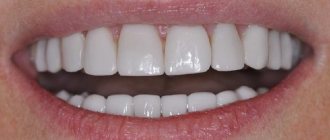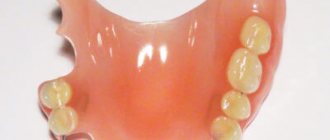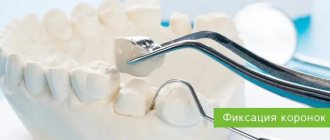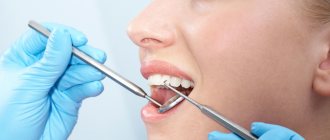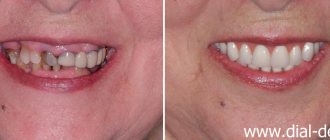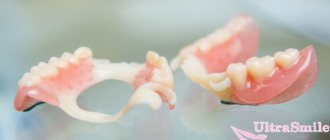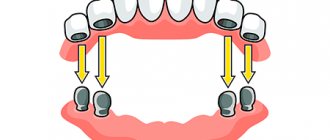138262
Dental prosthetics has always remained a popular service. Now dentists can offer a lot of options for restoring teeth.
Their main difference is not only in the characteristics of the design, but also in cost. As a rule, the cost consists of the type of prosthesis, the material used and the work of the doctor.
Do you need a pin for a crown?
If the doctor insists on prosthetics, this already means that the tooth has undergone significant destruction. The crown helps restore the chewing function of the damaged unit and the aesthetics of the smile, this is especially true for the frontal region. Obviously, the prosthesis must have the necessary support. If there is a sufficient amount of natural tissue, the crown is placed directly on the tooth. In other cases, pins and stump inlays come to the rescue.
- Tooth decay of more than 30% is a good reason for installing a pin and crown.
- A chip of one of the walls of a tooth by 50% or more or a fracture at the root are indications for installing a core inlay and crown.
The technology also has limitations. A pin cannot be placed if there is untreated pulpitis, periodontitis and their complications (cyst, gumboil, etc.). Treatment will have to be abandoned if there are abnormalities in the structure of the tooth roots (too much curvature or thin walls). In some situations, the doctor is unable to unfill the canals after previous endodontic treatment, which also affects the possibility of installing a pin.
How is the rehabilitation period after installation of a prosthesis?
During the period of soft tissue recovery after prosthetics and the patient’s adaptation to the structure, some problems may arise. For example, a denture may interfere with the usual closing of the jaws (due to the long-term absence of a tooth of normal anatomical shape). In some cases, gum inflammation, pain, and redness may occur. In general, this is all normal, since the doctor treated the tooth, the gums were injured, because it was necessary to align the position of the mucous membrane along the contour of the crown. But if the discomfort not only persists, but intensifies, you should tell your doctor about it. And as soon as possible.
You can avoid unpleasant sensations if you follow a gentle regimen in the first days after installing the prosthesis: gently brush your teeth with a soft brush, eat pureed food.
%akc72%
Inlay or pin: which is better?
The choice of support element depends on the specific clinical case. Both the pin and the core tab perform similar functions. However, each solution has its own advantages and disadvantages.
| Crowns on pins | Crowns on core inlays |
|
|
The stump tab is considered a more reliable option for chewing teeth and if it is necessary to install bridges. It is important to understand that this significantly increases the cost of treatment (the price per tab can reach up to 10,000 rubles). In addition, the manufacture of a stump insert requires an additional laboratory stage and appropriate manipulations.
Placing a crown on a pin can be recommended if the tooth does not have serious damage and there is no risk of pin breakage and root canal injury under the influence of chewing load. However, not all pins are suitable for the restoration of anterior teeth, especially if metal-free crowns are used. The crown and post on the front tooth should not contain metal if you want good aesthetics.
When installing a ceramic crown on a front tooth, the core inlay should also be made of ceramic.
Features of prosthetics
Installation of the structure requires a specialist’s painstaking work and care. It provides for the gradual implementation of professional manipulations.
Stages of installation of an orthopedic model:
- First, the doctor preliminarily examines the oral cavity. If there is any inflammation or carious process here, it treats the existing pathology.
- Preparation for work involves examining the tooth being treated and grinding down excess areas (if required).
- Making an impression of the dentition: a product is created from it.
- Installation of a temporary plastic structure. This is necessary to provide the oral cavity with the required aesthetics.
- Selecting the appropriate shade of crowns. This procedure requires careful attention from a specialist. Otherwise, the wrong color will stand out noticeably.
- Installation of the finished model. To fix it, a special composition is used that is not destroyed under the influence of negative factors.
In order for a metal-free structure to serve for a long time and not create problems, it must be installed by an experienced specialist.
Filling on a pin or crown: which is better?
This question interests many patients, and the answer is obvious. From the point of view of strength and reliability, the best option would be to install a pin and a crown. It is better to place a pin in a tooth under a crown in cases where the tooth is significantly damaged, especially when it comes to molars. A pin with a filling is installed for less significant damage and most often on the front teeth. This method also has its advantages. Firstly, this is a much cheaper technique. Secondly, all treatment takes place in one visit. The patient quickly returns to normal life and forgets about his problem. However, a filling with a pin gives a less reliable and predictable result.
Main characteristics
Metal-free crowns include products made from:
- plastics are cheap, but fragile, quickly stain and crack, usually used for temporary prosthetics;
- ceramic composite – consist of composite materials and ceramics;
- ceramics or porcelain - inorganic material obtained by processing nitrides, metal oxides, borides, carbides at high temperatures;
- zirconium dioxide (oxide) - similar in strength to metal, and in aesthetics - similar to ceramics.
When people talk about metal-free orthopedic structures, they usually mean zirconium dioxide and ceramics. The technology for prosthetics with these materials was developed in the 80s of the 20th century, but they began to be used on a large scale in the last ten years.
Despite the high cost, metal-free crowns are very popular
Sometimes patients confuse the concepts “metal-free” and “bimetallic”. The latter term means prostheses made from an alloy of two or more metals: gold, nickel, platinum, chromium, palladium, etc.
Stages of installing a crown on a pin
- Initial consultation, determination of indications and contraindications for treatment.
- Preparation of tooth tissues and depulpation of root canals.
- Installation of the pin.
- Taking impressions or 3D modeling. Sending the results to the laboratory to make a permanent crown. Immediately after the procedure, the patient is offered a temporary crown.
- Trying on the finished product and fixing the crown with a pin.
Disadvantages of ceramic dentures
The main disadvantage is the rather high cost. It is associated with the price of the material itself, the need to use high-precision, expensive equipment and a high level of specialist training.
Another disadvantage is the rapid wear of antagonist teeth - over time, their enamel wears off due to constant friction with ceramics. However, this is not a specific feature of ceramics - any restoration materials are denser than the tissue of a living tooth, so the process of gradual grinding down of the enamel is completely normal.
The fragility of ceramic products and the inability to install them on chewing teeth is also considered a negative quality, although dentists have now been able to achieve compositions that provide the necessary strength even under increased load. But here it is still better not to risk it and return to the traditional indication - restoration of only the group of frontal teeth.
Service life and design reliability
The service life of a crown on a tooth on a pin is quite decent if the treatment was carried out efficiently, and the patient avoided injury and followed the doctor’s recommendations. Even a classic metal-ceramic crown with a simple anchor pin costs on average 7–8 years. A more expensive ceramic crown on a fiberglass post will last even longer.
If during use the crown begins to wobble, then this is a bad sign, regardless of whether it is with a pin or without a pin. In this case, you need to consult a doctor as soon as possible. If the crown and pin fall out completely, this may be due to improper treatment, pathological processes in the root canals, or a banal injury. Repeated treatment in most cases is no longer possible.
Caring for metal ceramics
To increase the life of the crowns, some care must be taken immediately after completion of the prosthetics. Since gums may remain sensitive for some time, dentists recommend using a soft-bristled brush and appropriate toothpastes. Over time, you will begin to take care of your teeth as before. When worn Use mouth rinses after meals. Despite the fact that the coating is highly durable, you should definitely not chew nuts or open bottles with your teeth. Following the dentist’s recommendations will ensure the durability and aesthetics of artificial crowns.
Dentures help protect the tooth as a whole, but it does not prevent the development of caries or gum disease.
How much does it cost to put a crown on a post?
The price of the finished solution directly depends on the materials of the pin and crown. The cost of a regular anchor pin is 500 rubles, but for a fiberglass one you will have to pay more than 1000 rubles. But these figures pale in comparison with the range of prices for crowns. If ordinary metal-ceramics costs 6–8 thousand, then products made of ceramics and zirconium will cost three times more. All preparatory manipulations will need to be added to the final amount.
An E-Max ceramic crown on a fiberglass pin, together with all stages of treatment, can cost 30,000 rubles and even more if we are talking about a VIP-class clinic. You can also choose a budget option with a metal-ceramic crown and an anchor or titanium pin. This solution will cost from 12,000 rubles, but is not suitable in all cases.
Cost of services
If treatment is started on the day of treatment, consultation and treatment plan are free
| Temporary crown (laboratory manufacturing method) | RUR 2,500 |
| Solid crown | RUB 7,900 |
| Metal-ceramic crown with ledge | RUB 13,700 |
| Metal-ceramic crown | RUB 11,500 |
| MK crown using shoulder masses | RUB 15,500 |
| Metal-ceramic crown supported by an implant | 28,000 rub. |
| All-ceramic crown | RUB 16,500 |
| Ceramic crown on a zirconium dioxide frame | 40,000 rub. |
| Core inlay CoCr | 7,000 rub. |
| Stump inlay silver | RUB 8,900 |
| Partial removable denture | 22,000 rub. |
| Complete removable plate denture (1 person) | 25,000 rub. |
| Plate prosthesis reinforced with mesh | RUB 32,500 |
| Removable nylon prosthesis “Quattroti” (1 person) | 55,000 rub. |
| Removable denture with 1-2 teeth | 8,000 rub. |
| Partial removable plate denture made of ImplFcryl plastic (including silicone and imported teeth) (1 person) | 45,000 rub. |
| Complete removable plate denture made of ImplFcryl plastic (including silicone and imported teeth) 1 person. | 55,000 rub. |
| Clasp prosthesis (2-3 clasps) | 35,000 rub. |
| Clasp prosthesis with locking fastenings “Bredent” | 65,000 rub. |

